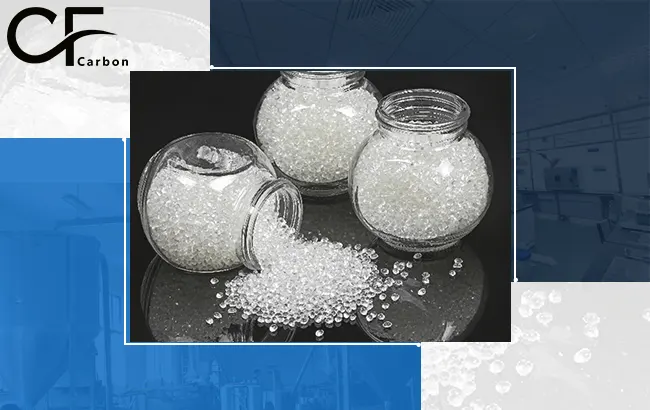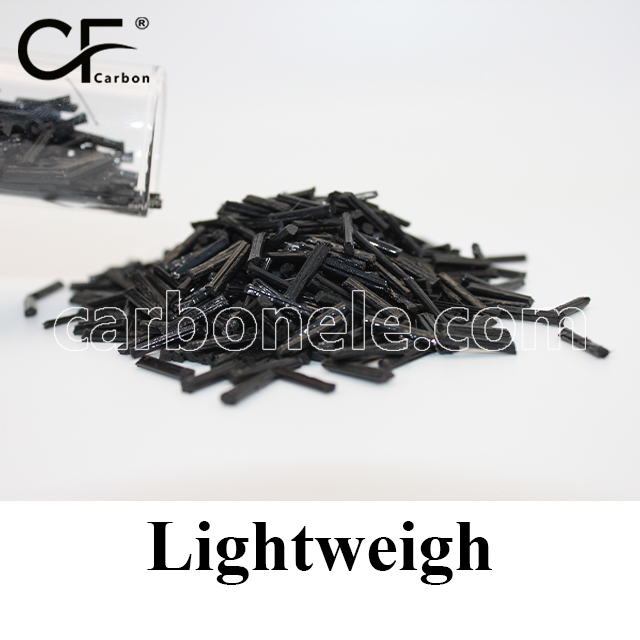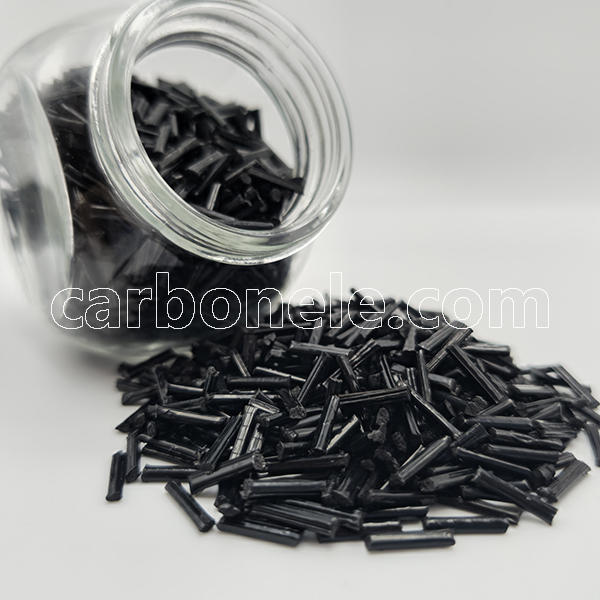
Wear Resistance LCF30-TPU LCF30 Factory Prices Per KG
TPU LCF30 has several outstanding properties. It has high strength and modulus, with good elongation, outstanding wear resistance, good temperature resistance, low density, and good processing performance, making it superior to traditional materials and suitable for various applications.
- Model No.: TPU-LCF-BCA3
- Matrix Resin: TPU
- Reinforcing Filler: Long carbon fiber
- Molding Process: Injection/extrusion
- Free Sample: 2-8kgs
- MOQ: Negotiable
I. Composition of TPU LCF30
It uses thermoplastic polyurethane (TPU) as the base material and 30% long carbon fiber as the filling material. The filling mass percentage of carbon fiber reaches 20%. The introduction of long carbon fiber greatly enhances the performance of the material.
II. Synthesis Process
First, conduct fine surface treatment on the long carbon fiber to enhance its surface activity so that it can better combine with TPU. Then, slowly place the treated long carbon fiber into the TPU melt for full impregnation.
By strictly controlling specific process parameters such as temperature, pressure, and time, ensure that the carbon fiber is fully impregnated in the TPU to achieve a tight combination.
Next, transport the impregnated carbon fiber and TPU mixture to the extrusion equipment. Through precise extrusion molding process, the material forms a specific shape and structure.
Finally, after a series of subsequent processes such as cooling and cutting, high-quality Wear Resistance TPU LCF30 composite material is obtained.
III. Performance Characteristics
1. High strength: The tensile strength is quite high. Under the same volume, its strength is far superior to traditional materials and can withstand large external forces without deformation.
2. High modulus: The elastic modulus is relatively high, with minimal deformation when subjected to force and excellent dimensional stability.
3. High elongation: It has good elongation ability, and its flexibility and tensile resistance are outstanding.
4. Outstanding wear resistance: It can maintain good wear resistance in various harsh environments and significantly extend the service life of products.
5. Good temperature resistance: It can maintain excellent performance in low-temperature environments and also work stably within a certain high-temperature range.
6. Low density: Compared with metal materials, it has a lower density, which helps to achieve product lightweighting.
7. Good processing performance: It can be processed by various common processing methods and adapt to the manufacturing needs of different products.
IV. Application Fields
It is widely used in many fields such as aerospace, automobile manufacturing, electronic products, and sports equipment.
If you would like to learn more info on applications of carbon fiber filled TPU blends, please click here.
Application Scenario Case
In the field of sports equipment, the Wear Resistance TPU LCF30 composite material produced by Carbon (Xiamen) New Material is successfully applied to the frame manufacturing of high-end tennis rackets.
The high strength and high modulus characteristics of this composite material make the tennis racket frame show excellent stability and no deformation when facing high-intensity hitting impact.
Whether it is the powerful smash of professional players or the vigorous hitting of amateur players, this tennis racket can provide a stable and reliable hitting platform for players.
Its excellent wear resistance enables the racket to maintain a good appearance and performance during long-term and frequent use, greatly extending the service life of the racket.
The high elongation endows the racket with certain flexibility. At the moment of hitting, it can better absorb vibrations and reduce arm injuries, allowing players to protect their bodies while enjoying intense competitions.
Moreover, the low density of this material makes the tennis racket lighter and easier for players to carry and use.
After professional actual testing, the tennis racket made of TPU LCF30 composite material is 15% lighter than traditional aluminum alloy rackets, which means that players can reduce physical consumption and improve competitive status during long-term matches.
At the same time, its strength is increased by 25%, which makes the racket more sturdy and durable and can withstand various harsh usage environments.
This innovative application brings better sports equipment to the majority of tennis enthusiasts and also injects new vitality and impetus into the development of the sports equipment industry.
Excellent Processability TPU
TPU provides the base matrix for the composite material. It gives the material flexibility and a certain degree of elasticity. It also helps in binding the long carbon fibers together, ensuring the overall stability and integrity of the composite. Additionally, TPU contributes to the material's processability, allowing it to be molded and shaped easily using common processing methods. Moreover, it imparts some degree of toughness and impact resistance to the composite.

High Tensile Strength LCF
Due to their high tensile strength, they allow the composite to endure large external forces without deformation, raising the modulus of the material, leading to less deformation under stress and enhanced dimensional stability. They enhance the abrasion resistance of the composite, making it appropriate for applications in harsh environments. Long carbon fibers endow the material with excellent thermal conductivity, aiding in heat dissipation. In addition, they contribute to the overall firmness and rigidity of the composite and also offer a certain degree of electrical conductivity in some cases.

How to Get the Materials?
Thermoplastic composites produced by different manufacturers may have different emphases and variations in performance. If you need more accurate and detailed information, it is recommended to refer to the product manuals and technical data sheets of relevant manufacturers or contact us directly.

Frequently Asked Questions
Carbon (Xiamen) New Material Co., Ltd. aims to provide buyers with "one-stop" worry-free high-quality services. Here you can find all information about carbon fiber engineering plastics. If you still have questions, please send us an email for consultation!
-
How can I contact the manufacturer of a product that interests me?
When you find a product you are interested in, you can contact the manufacturer directly by sending an email and we will get back to you as soon as possible.
-
How do I find the products that interest me?
All you need to do is enter the keyword, product name in the search window and press the Enter key on your keyboard. Your search results page will then be displayed. You can also search within the product category pages on the home page. Each category is divided into subcategories, allowing you to refine your search and find products that interest you.
-
Where will I find a buying guide?
Please contact our after-sales service directly and we will provide you with a comprehensive operating guide.
-
What are CF Reinforced Thermoplastic Composites?
CF Reinforced Thermoplastic Composites are materials where carbon fibers are incorporated into a thermoplastic matrix. They combine the strength and stiffness of carbon fibers with the processability and recyclability of thermoplastics. For instance, they are used in automotive parts like bumper beams.
-
What are the benefits of CF Reinforced Thermoplastic Composites over traditional composites?
The key benefits include faster production cycles, easier recyclability, and better impact resistance. They also offer design flexibility. An example is in the manufacturing of consumer electronics casings where complex shapes can be achieved more easily.
-
How are CF Reinforced Thermoplastic Composites processed?
Common processing methods include injection molding, extrusion, and compression molding. Injection molding is widely used for mass production. For example, in the production of small components for the medical industry.
-
What industries use CF Reinforced Thermoplastic Composites?
They are utilized in aerospace, automotive, medical, and sports equipment industries. In aerospace, they can be found in interior components. In the medical field, they might be used in prosthetics.
-
How does the carbon fiber content affect the properties of the composites?
Higher carbon fiber content generally leads to increased strength and stiffness but may reduce ductility. A moderate content is often balanced for specific applications. For example, a higher content might be preferred in structural parts of a race car.
-
What are the challenges in using CF Reinforced Thermoplastic Composites?
Challenges include higher material costs, complex processing equipment requirements, and ensuring uniform fiber dispersion. Issues with adhesion between the fibers and the matrix can also arise. An example is in achieving consistent quality in large-scale production.























